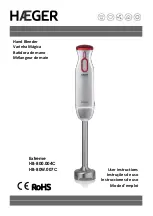
TP Cable Advantages
Twisted pair cable is much smaller, lighter, more flexible, and less expensive than coaxial
or HDMI cable. These transmitter and receiver twisted pair (TP) products make cable runs
simpler and less cumbersome. Termination of the cable with RJ-45 connectors is simple,
quick, and economical.
NOTES:
• The transmitter and receiver pair works with unshielded twisted pair
(UTP) or shielded twisted pair (STP) cables; but, to ensure FCC Class A
and CE compliance, STP cables are required.
• Do not use Extron UTP23SF-4 Enhanced Skew-Free
™
A/V UTP
cable to link the transmitter and receiver. Skew-free A/V cable was
designed for most Extron TP transmitter/receiver applications, but the
HDMI 201 Tx/Rx does not work properly with this cable.
Control Communications
The RS-232 or infrared (IR) communications are pass-through only; the transmitter and
receiver do not generate or respond to these signals.
Transmission Distance
The maximum transmission distance is determined by the resolution of the signal and the
TP cable that is used.
•
With CAT 5/5e/6 unshielded TP cable
, the Tx/Rx pair can transmit and receive 720p
and 1080i HDTV or XGA video signals up to 200 feet (60 m) and 1080p HDTV or
UXGA video up to 100 feet (30 m).
•
With CAT 5/5e/6 shielded TP cable
, the Tx/Rx pair can transmit and receive 720p
and 1080i HDTV or XGA video signals up to 200 feet (60 m) and 1080p HDTV or
UXGA video up to 125 feet (38 m).
NOTES:
• The transmission distance varies greatly, depending on the signal
resolution, type of cable used, graphics card, and display used in the
system.
• For resolutions of 1600x1200, 1920x1200, and 1080p, Extron strongly
recommends DTP26 cable, or equivalent. Extron DTP26 cable consists
of four individually shielded copper pairs and an overall braided shield
that help reduce crosstalk. DTP26 cable extends these resolutions up to
150 feet (45 m).
HDMI 201 • Introduction
3










































